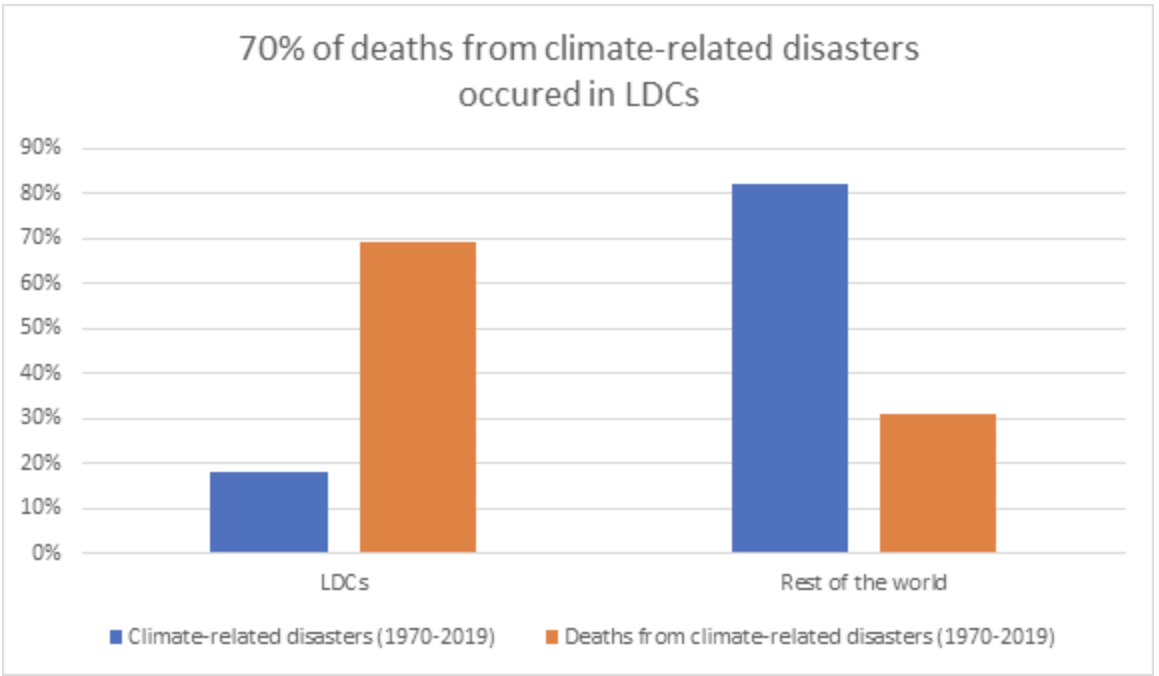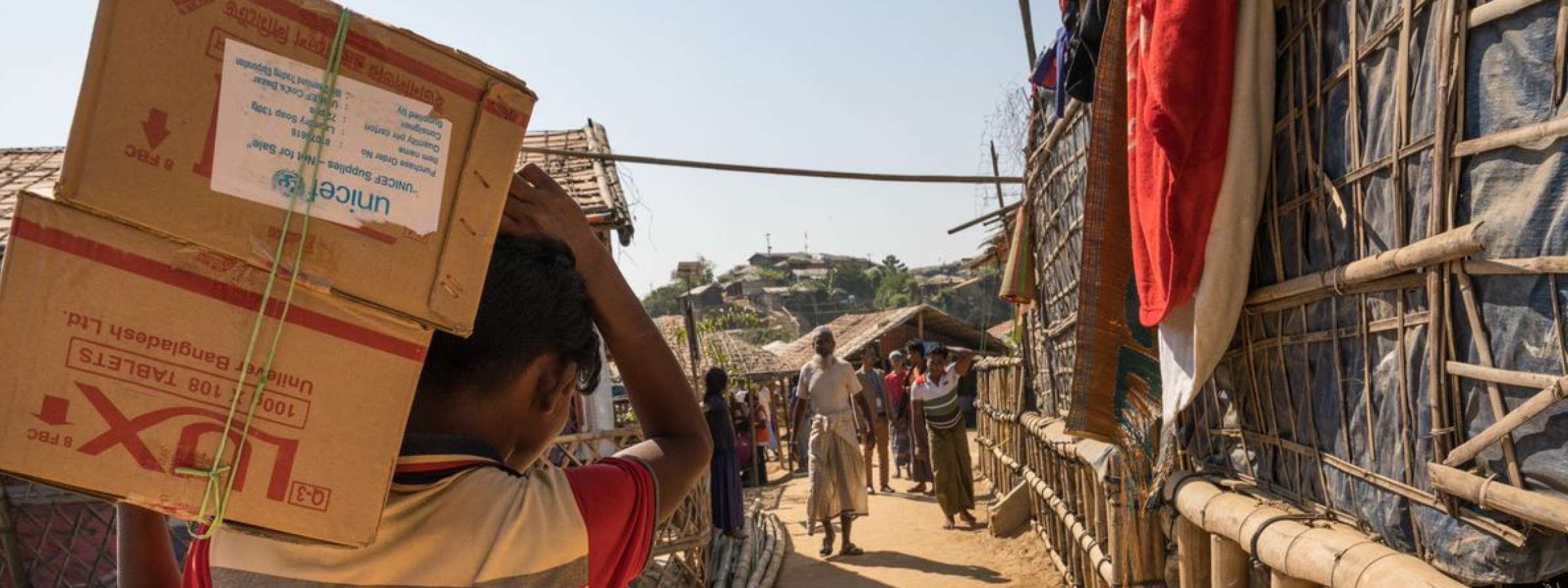Disasters undermine development
The devastating impacts of the COVID-19 crisis and the climate emergency demonstrate how the systemic nature of risk and the cascading impacts of disasters affect every facet of society and economies in the LDCs, from agricultural and industrial development, to human mobility and urbanization, as well as food security and the provision of basic services. For some LDCs, disaster risk is further compounded by protracted humanitarian crisis and conflict dynamics.
Facts and Figures
Impact of disasters on LDCs
- Disasters impact all countries, but LDCs are disproportionately impacted
- LDCs have contributed nearly 1% of global emissions but have seen a five-fold increase in climate-related hazards since the 1970s (UNCTAD, 2022).
- LDCs have experienced nearly 70% of the deaths caused by climate-related disasters over the last 50 years (WMO, 2020).
- Disasters impact the economies of LDCs around 10 times worse than the economies of the richest countries, as a share of their GDP (UNDRR GAR, 2022).
- More than 8.5 million people living in LDCs were displaced due to disasters in 2020 (Internal Displacement Monitoring Centre, 2021).
- Droughts were the deadliest and floods the costliest hazard events in LDCs (WMO, 2020).
- Over 34 percent of crop and livestock production loss in LDCs is traced to drought, costing the sector USD 37 billion between 2008 and 2018. (FAO, 2021).
- Floods are responsible for a total of USD 21 billion of the crop and livestock production loss 2008-2018 in LDCs - this amounts to 19 percent of total loss (FAO, 2021).
State of Disaster Risk Reduction (DRR) in LDCs
- 61% have national disaster risk reduction strategies
- 46% reported having a multi-hazard early warning system
- 22% are reporting on the implementation of the Sendai Framework
- 17% have access to disaster risk information
- 12% have cities in the Making Cities Resilient 2030 initiative.


"Despite contributing the least to the climate crisis, LDCs continue to bear the brunt of disaster impacts"
Call to action
It would be impossible for LDCs to achieve the Sustainable Development Goals, if they are constantly recovering from disasters. Therefore, disaster risk reduction must be embedded within national development strategies, smooth transition strategies, and international cooperation.
Increase political commitment to integrate risk reduction and resilience into structural transformation and sustainable development strategies in the LDCs:
- Develop and strengthen national and local disaster risk reduction strategies that take a comprehensive approach to climate and disaster risk governance, and ensure policy and investment decisions in all sectors are aligned with these strategies.
- Adopt an approach to structural transformation that reduces rather than creates disaster risk, including reducing underlying economic, social, and environmental drivers of exposure and vulnerability.
- Integrate disaster risk reduction into all policies and strategies related to productive capacity development, including industrial and agricultural development, commodity diversification, and trade and supply chains to ensure they are resilient against current and future shocks and hazards, including the impacts of climate change.
- Resilient infrastructure is critical for sustainable productive capacity development and access to global markets. Invest in resilient infrastructure and ensure comprehensive risk assessment is a prerequisite for all investments in critical infrastructure, including digital and energy infrastructure, as well as housing and basic social services.
- Integrate disaster risk reduction into the smooth transition strategies of graduating countries to promote sustainability of development progress, including through the support provided by the Sustainable Graduation Support Facility.
Significantly improve knowledge and understanding of disaster risk in the LDCs
- A radical scale-up in adaptation measures and a comprehensive approach to risk analysis and management covering a full range of hazards is required. Current capacity for risk analytics in the LDCs do not enable effective preventive and anticipatory action.
- Build capacity and provide technical support to all sectors to regularly conduct and update comprehensive climate and disaster risk assessments and apply the information in policy and investment decisions.
- Strengthen capacity for risk analytics among academia and the science and technology sector, including among young scientists and professionals.
- Invest in building systems to collect and analyze disaster loss data as well as technology and geographic information systems to collect and analyze multi-hazard disaster risk data, including enhanced transfer of technology to the LDCs.
- Invest in multi-hazard early warning systems that lead to early action and strengthen hydrometeorological services, including climate forecasting, to inform social protection measures.
- Focus on the communication of risk information in ways that can be easily understood by decision makers in the public and private sector as well as communities and households.
Accelerate predictable funding and financing and risk-informed investments for the LDCs
- Disaster related funding remains disproportionately focused on response and recovery. Only 50 cents of every $100 of international assistance related to disasters is invested in prevention and risk reduction.
- Bilateral donors, development banks and international financial situations to integrate disaster risk reduction into their assistance to the LDCs in all sectors and ensure their support is aligned with national and local disaster risk reduction strategies the Sendai Framework.
- Honour pledges to increase financing for climate change adaptation in the LDCs and ensure climate finance is risk-informed.
- Significant funding is needed to implement the UN Secretary-General’s Early Warnings for All Initiative, which aims to ensure every person in the world is covered by early warning systems by the year 2027
- Public finance mechanisms in the LDCs should be reviewed through ‘Risk-Sensitive Budget Reviews” and enhanced tagging and tracking of budgetary and expenditure flows to ensure investments in disaster and climate risk management across sectors, plans and budgets and in integrated national financing frameworks for sustainable development.
- Establish a pipeline of investable infrastructure projects that are disaster and climate resilient.
- LDCs account for a mere 1% of global trade and 1.4% percent of global foreign direct investment. Focus on de-risking investments in the LDCs and creating an enabling environment for investments in disaster risk reduction and resilience.
- Leverage partnership with the private sector should to co-develop innovative financial instruments targeted to the LDCs.
- Support small and medium enterprises to reduce risk across their operations and build resilience to disasters.
DRR and LDCs on the global policy agenda
Much has changed since 2011, not least the adoption of the Sendai Framework for Disaster Risk Reduction. Today, there is a strong recognition that the impacts of disasters and increasing levels of disaster risk, exacerbated by the climate crisis and the COVID-19 pandemic, severely undermine progress towards sustainable development in the LDCs. There is also a greater appreciation of the need for a risk-informed approach to successfully implement the 2030 Agenda for Sustainable Development and the Paris Agreement, which is now reflected in the Secretary-General’s seminal report on “Our Common Agenda ”. Furthermore, in June 2021, the ECOSOC resolution on LDC graduation recognized the relevance of disaster risk and the impact of disasters for the LDC graduation process. The resolution calls for disaster risk reduction to be included in the smooth transition strategies of graduating countries and for greater support from development partners for disaster risk reduction and resilience in graduating countries
The Opportunity
- Implementation of the Doha Programme of Action must put all LDCs on the path to graduation from the category by 2030. Business as usual is not an option. Exposure and vulnerability to disasters are long-standing structural impediments to sustainable development in the LDCs. Now is the time for a truly risk-informed economic and development model for the LDCs. Reducing risk and building resilience is embedded within the Doha Programme of Action. Its implementation must go hand-in-hand with the implementation of the Sendai Framework for Disaster Risk Reduction.
- The LDC-5 Conference and the Doha Programme of Action provide an unprecedented opportunity to chart a new course that can significantly reduce disaster losses in the LDCs. The adoption of the Programme of Action must spell the end for risk-blind planning and investing in the LDCs. This requires greater political commitment from the LDCs to integrate disaster risk reduction into economic and development planning. This commitment must be met with sustained and increased international development cooperation to support the means of implementation for disaster risk reduction and resilience in the LDCs.
The Fifth United Nations Conference for the Least Developed Countries (LDC-5)
The Fifth United Nations Conference for the Least Developed Countries (LDC-5) will be hosted by the Government of Qatar in Doha. The LDC5 conference will be held in two parts. The first part took place at the United Nations Headquarter in New York on 17 March 2022, where the Doha Programme of Action (DPoA) was adopted. Member States and stakeholders discussed the implementation of DPoA which outlines the development priorities of and international support for the LDCs over the next decade. The second part will take place in Doha from 5-9 March, 2023. This will be an in-person gathering where world leaders will gather with civil society, the private sector, young people and more to build new plans and partnerships for the delivery of the DPoA over the following decade.
The Programme of Action includes the following disaster risk reduction related targets and commitments:
- Establishing national platforms and national strategies to implement the Sendai Framework;
- Strengthening multi-hazard early warning systems;
- Establishing a multi-hazard crises mitigation and resilience building mechanism for LDCs;
- Strengthening national statistical and planning capacity and inter-institutional coordination mechanisms for the collection, analysis and use of disaster risk and loss data;
- Adopting legislation, policies and standards for disaster risk reduction;
- Integrating disaster risk reduction into the LDC graduation process; and
- Enhancing funding for disaster risk reduction, including aligning public and private, domestic and international investment with national and local disaster risk reduction strategies, and incorporating impacts of disaster and climate risks into decisions taken by monetary and regulatory authorities.
